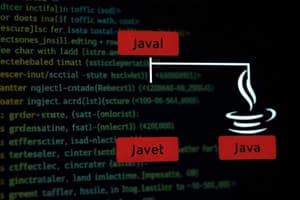Podcast
Questions and Answers
Explain the difference between == and the .equals() method when comparing objects in Java. Why is it important to use .equals() for comparing the content of objects?
Explain the difference between == and the .equals() method when comparing objects in Java. Why is it important to use .equals() for comparing the content of objects?
== compares references, checking if two variables point to the same object in memory. .equals() compares the actual content of the objects. Using .equals() ensures you're comparing values, not memory locations.
Describe the concept of method overloading in Java. Give an example of how method overloading can be useful in a class.
Describe the concept of method overloading in Java. Give an example of how method overloading can be useful in a class.
Method overloading is when a class has multiple methods with the same name but different parameters (different types, number, or order). This allows you to use the same method name for similar operations on different data types or with varying inputs, enhancing code readability and flexibility. For example, several add methods that can take in different numbers of parameters.
Explain the purpose of static variables and methods in Java. How do they differ from instance variables and methods?
Explain the purpose of static variables and methods in Java. How do they differ from instance variables and methods?
static variables and methods belong to the class itself, not to any specific instance of the class. Instance variables and methods belong to each object. static members are shared among all instances, while instance members are unique to each instance.
What is the difference between an interface and an abstract class in Java? When would you choose to use one over the other?
What is the difference between an interface and an abstract class in Java? When would you choose to use one over the other?
Explain the concept of exception handling in Java. Why is it important, and what are the key keywords used in exception handling?
Explain the concept of exception handling in Java. Why is it important, and what are the key keywords used in exception handling?
Describe the difference between checked and unchecked exceptions in Java. Give an example of each.
Describe the difference between checked and unchecked exceptions in Java. Give an example of each.
What is multithreading in Java, and why is it useful? Explain how you can create a new thread in Java using the Runnable interface.
What is multithreading in Java, and why is it useful? Explain how you can create a new thread in Java using the Runnable interface.
What are the different states in the lifecycle of a thread in Java? Briefly describe each state.
What are the different states in the lifecycle of a thread in Java? Briefly describe each state.
Explain the purpose of the synchronized keyword in Java. How does it help prevent race conditions in multithreaded environments?
Explain the purpose of the synchronized keyword in Java. How does it help prevent race conditions in multithreaded environments?
Describe the purpose and function of the Executor framework in Java concurrency. How does it simplify the management of threads compared to explicitly creating and managing Thread objects?
Describe the purpose and function of the Executor framework in Java concurrency. How does it simplify the management of threads compared to explicitly creating and managing Thread objects?
Flashcards
Programming Style (Java)
Programming Style (Java)
A set of rules that define how Java code should be written and formatted for readability and consistency.
Data Types in Java
Data Types in Java
Numeric (int, double), text (String), true/false (boolean), and single characters (char). Defines what type of data a variable can hold.
Operators in Java
Operators in Java
Symbols used to perform operations on variables and values.
"If" Statement
"If" Statement
Signup and view all the flashcards
Method Overloading
Method Overloading
Signup and view all the flashcards
Arrays
Arrays
Signup and view all the flashcards
Object-Oriented Programming (OOP)
Object-Oriented Programming (OOP)
Signup and view all the flashcards
Encapsulation
Encapsulation
Signup and view all the flashcards
Exception Handling
Exception Handling
Signup and view all the flashcards
JavaFX
JavaFX
Signup and view all the flashcards
Study Notes
- This document outlines the course "Object Oriented Programming - I" for the Bachelor of Engineering program at Gujarat Technological University
- The course code is 3140705
- The course is a core course and has no prerequisites
Rationale
- Object-oriented programming (OOP) is fundamental in software development due to its support for code reuse, flexibility, and effective problem-solving
- OOP offers a modular structure, hides implementation details, and reduces development costs through code reuse
Teaching and Examination Scheme
- The course has a teaching scheme of 4 Lecture hours, 0 Tutorial hours, and 2 Practical hours per week
- It carries 5 credits
- The examination includes 70 marks for End Semester Exam (ESE) theory, 30 marks for Practical Assessment (PA) theory, 30 marks for ESE practical, and 20 marks for PA practical, totaling 150 marks
Course Content
Introduction to Java and Elementary Programming
- Covers Java language specifications, APIs, JDK, and IDEs
- Includes creating, compiling and executing simple Java programs
- Teaches programming style, documentation, and error handling
- Covers identifiers, variables, assignment statements, named constants, naming conventions, and data types (Numeric, Boolean, Character, String)
- Includes operations, literals, evaluating expressions, operator precedence, types of operators (augmented assignment, increment, decrement, logical), operator precedence and associativity, and numeric type conversions
Selections, Mathematical Functions, and Loops
- Focuses on if statements (two-way, nested, multi-way), switch statements, conditional expressions, and common mathematical functions
- Teaches while, do-while, and for loops, nested loops, and the break and continue keywords
Methods and Arrays
- Discusses defining and calling methods, passing arguments by values, overloading methods, and scope of variables
- Covers method abstraction, stepwise refinement, single-dimensional arrays, copying arrays, and passing/returning arrays from methods
- Includes searching, sorting, the Array class, two-dimensional arrays and their processing, passing two-dimensional arrays to methods, and multidimensional arrays
Objects and Classes
- Covers defining classes for objects and constructors
- Includes accessing objects via reference variables and using classes from the Java library
- Discusses static variables, constants, methods, visibility modifiers, data field encapsulation, passing objects to methods, array of objects, and immutable objects and classes, along with variable scope and the "this" reference
Object-Oriented Thinking
- Focuses on class abstraction, encapsulation, thinking in objects, and class relationships
- Includes primitive data types and wrapper class types, BigInteger, BigDecimal, String, StringBuilder, and StringBuffer classes
- Discusses superclasses and subclasses, the "super" keyword, method overriding and overloading, polymorphism, dynamic binding, casting objects, and the "instanceof" operator
- Covers the ArrayList class and its methods, along with protected data and methods
Exception Handling, I/O, Abstract Classes, and Interfaces
- Covers exception types, the "finally" clause, rethrowing exceptions, and chained exceptions
- Includes defining custom exception classes, the File class, input/output operations, and reading data from the web
- Discusses abstract classes, interfaces, and the Comparable and Cloneable interfaces
JavaFX Basics, Event-Driven Programming, and Animations
- Covers the basic structure of a JavaFX program, panes, UI controls, and shapes
- Includes property binding, the Color and Font classes, Image and ImageView classes, layout panes, shapes, events, event sources, registering handlers, handling events, inner classes, anonymous inner class handlers, mouse and key events, listeners for observable objects, and animations
JavaFX UI Controls and Multimedia
- Details labeled controls, buttons, checkboxes, radio buttons, text fields, text areas, combo boxes, list views, scrollbars, sliders, video, and audio
Binary I/O, Recursion, and Generics
- Teaches Text I/O, Binary I/O, Binary I/O classes, Object I/O, and Random Access files
- Includes problem-solving using recursion, recursive helper methods, and tail recursion
- Covers defining generic classes and interfaces, generic methods, raw types, backward compatibility, wildcard generic types, erasure, and restrictions on generics
Lists, Stacks, Queues, and Priority Queues
- covers collections, iterators, lists, the comparator interface, static methods for list and collections, vector and stack classes, queues, and priority queues
Sets and Maps
- Compares performance of Sets and Lists
- Covers singleton and unmodifiable collections and Maps
Concurrency
- Explains thread states and life cycle
- Covers creating and executing threads with the Executor Framework and thread synchronization
Studying That Suits You
Use AI to generate personalized quizzes and flashcards to suit your learning preferences.




